There’s a lot of talk currently about the weight of cars and the popularity of SUVs. No doubt, all cars have become larger and heavier over the years, but there are smaller, lighter and even more efficient EV options out there too.
Late last year we sold our 2017 30 kWh Nissan Leaf, after an enjoyable and trouble free 38 months of ownership, and bought a 2021 VW e-up!
Accommodation & Equipment
The e-up!’s boxy design, with all 4 wheels pushed out to the corners, maximises the interior space of this little 5 door hatchback. It’s a 4 seater (no middle seatbelt in the rear) and at just 3.6 meters long it doesn’t take up much room. And those dimensions are never more welcomed than when trying to navigate the alloy-wheel-murdering bends of a modern multi-storey car park.
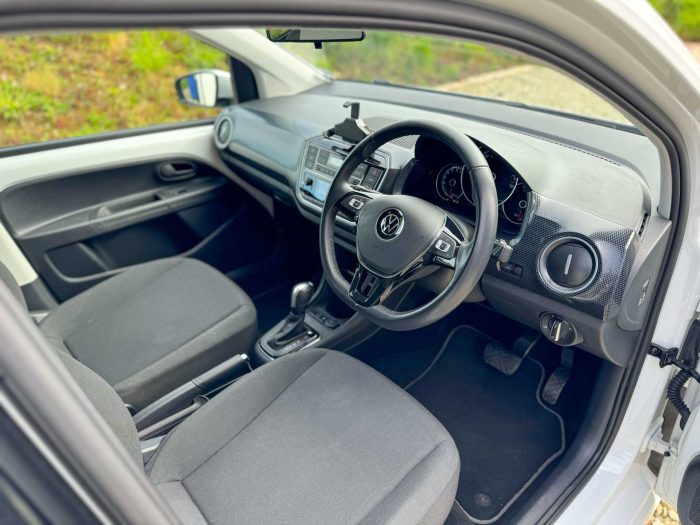
While the interior finishes are basic, the seats are comfortable and the car retains a quality feel. Standard equipment includes a reversing camera (with the world’s smallest screen), electric front windows (pop open on the rear), cruise control, lane assist, a heated front windscreen (the type with an element embedded into the glass) a multifunction steering wheel, heated front seats, parking sensors, auto lights, auto wipers, privacy glass and 2 x ISOFIX in the rear. There are 3 things we miss from the Leaf, the heated steering wheel, one-shot up/down electric windows and keyless go.
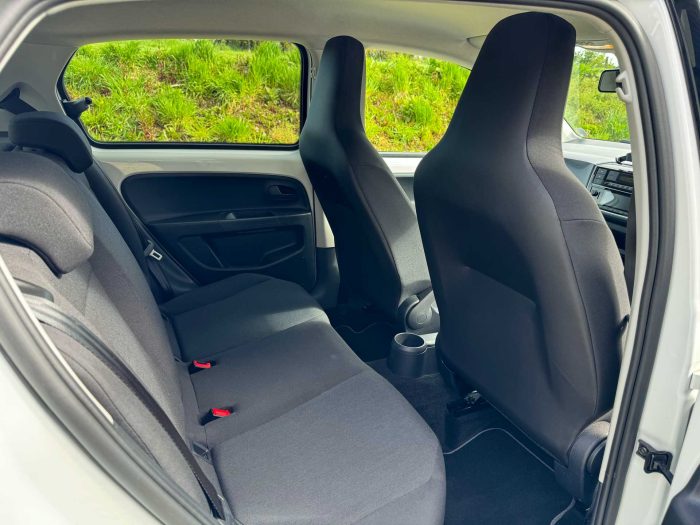
There are 2 apps for the up!. The one named ‘Volkswagen’ allows control of the aircon, so starting to heat or cool the car remotely is only ever a couple of taps away.
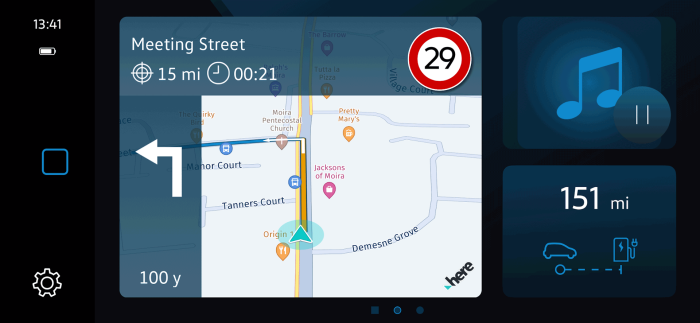
The other is ‘maps+more’ which integrates with the car’s infotainment system to augment the controls and offer navigation. I don’t use this one though, preferring Waze for satnav duties.
The audio system sounds great and the lack of a touchscreen helps to keep costs down. The built-in phone cradle works well, with ratcheting width and height adjustments and a USB A socket just behind it for charging.
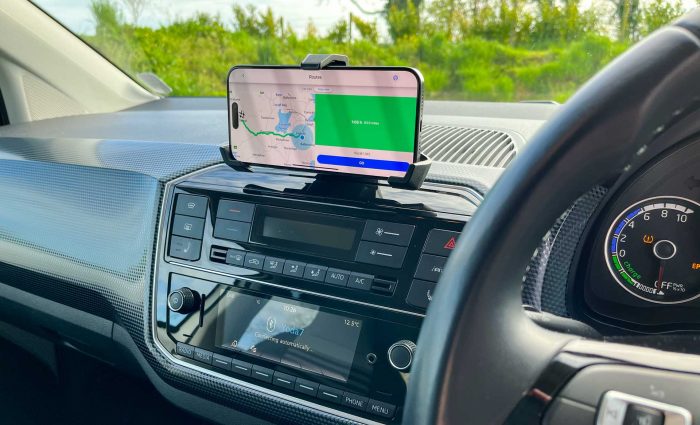
Despite only achieving a 3 star Euro NCAP safety rating, the passenger scores are actually decent, with the car being marked down on its lack of modern active Safety Assist systems and its less pedestrian-friendly collision outcomes.
While you won’t be taking this car to pick up your new Ikea wardrobe, the little 250 litre boot is practical enough and will hold the weekly shop. With the rear seats folded down, that increases to around 1,000 litres, allowing you to transport plenty of larger items too. There’s a well thought out slot at the back of the boot that neatly holds the Type 2 AC cable as well as the included mobile ‘granny’ charger.

Performance, Handling & Ride
The e-up! is front wheel drive with the single motor maxing out at 61 kW (82 hp), providing a 0-62 mph time of 11.9 seconds and a top speed of 81 mph. Driving it reminds me of cars I owned in the 80’s, where less power meant maintaining momentum was half the fun. It’s enjoyable on a B road and it won’t be a surprise that it handles a bit like a go-kart in the bends. It’s comfortable too, with a ride that’s more sophisticated than our larger car. This 2021 model came with 15″ ‘Tezzle’ alloy wheels and their smaller size adds to the comfort and efficiency too.
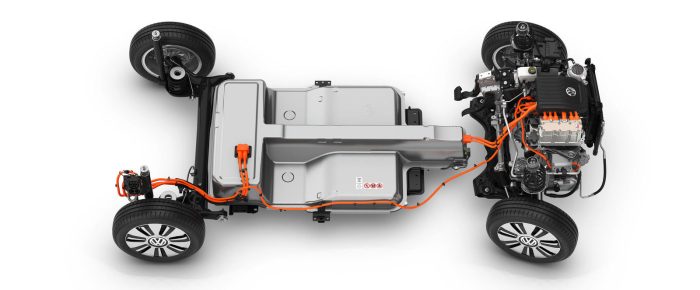
One of the best things about driving the e-up! is its strong regen. There are four levels available, but pulling the ‘gear lever’ back into B gets you straight to the most powerful setting and with space you can bring the car to a complete stop without touching the brake pedal. It’s a huge upgrade from the Leaf and provides a one-pedal driving experience that comes much closer to the Tesla.
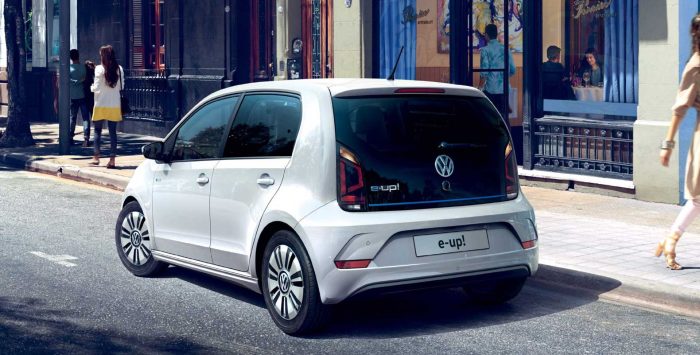
Design
The up! is a loveable classic, and while the 5 door is not quite as cool looking as its 3 apertured sibling, the all-glass black rear tailgate, LED daytime running lights and dinky dimensions all combine into a cute design with bags of personality.
Interestingly, it has also proven to be less scary to friends that have sat in it that are considering changing over from a traditional piston vehicle to an EV. It’s much less ‘space ship’ than other electric cars, the dials look normal (the battery display is just like a fuel gauge), there’s a conventional looking automatic gear stick, and even an old-school manual handbrake lever sitting between the seats.
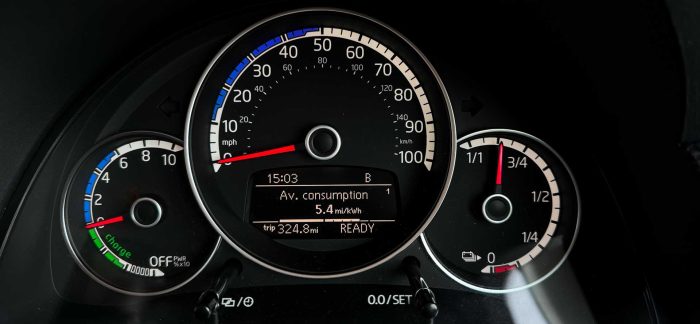
Some design quirks include a heating system that defaults to 22 degrees, a strange decision for a car that uses a basic resistive heater and not a heat pump. This can be changed if you know someone with the correct app and ODB2 adapter, which can be used to code the car to remember its last set temperature instead. This same setup can be used to change the Lane Assist button to remember its last state too.
Charging & Efficiency
The original e-up! had a tiny 16.0 kWh battery (18.7 kWh gross). Face-lifted in late 2019, that was doubled to 32.3 kWh (36.8 kWh gross) with a WLTP range of 159 miles.
The charging flap is on the right rear quarter panel and both parts of the CCS2 socket use plastic covers (beware of the CCS Trap). The maximum DC charging rate is fairly leisurely 37 kW, but with its small battery it can go from 20% to 80% in around 40 minutes. On the AC side there’s an onboard 7.2 kW charger (on some earlier cars this may also need coded to switch over from a 3.6 kW default).

While it will sit comfortably on the motorway at 70 mph, our journeys tend to be cruising at around 40-50mph on rural roads instead. We’ve owned the VW for 4 months now and even though the majority of that time has been across the colder season (December to April), we have already averaged 4.9 miles per kWh. I fully expect that to go over 5.0 for a full year, and it’s not uncommon to see 6 miles per kWh or more on some trips. But for now, our real world range calculates out as follows –
4.9 miles/kWh x 32.3 kWH Usable = 158 mile range
This is one occasion where I’d disagree with the EV Database. Their real world figures of 125 miles seems overly pessimistic. The range shown for a 100% charge varies, and is based on your most recent driving. You can see from the app screenshot below that we’ve already seen that 180 miles is achievable, even in these colder months. So this energy-sipping EV can easily hit its WLTP range, and go on to better it significantly in the milder months.

At 1,235 kg the e-up! is significantly lighter than most other EVs which contributes to this efficiency. Using Northern Ireland’s cheapest overnight tariff (13.99p / kWh at the time of writing), it currently costs a miserly 2.8p in electricity per mile.
Verdict
Changing from the Leaf has increased our 2nd car range from 100 to 160 miles, opening up the opportunity to do many more journeys without having to take the bigger car. At the same time it has removed the hunt for CHAdeMO rapids, making even longer trips a stress free option. The warranty covers the battery for 8 years, or 100,000 miles for more peace of mind.
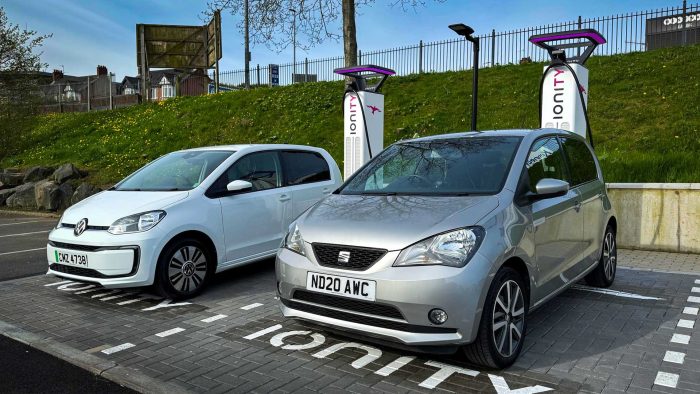
This is one EV with 3 different badges. The Volkswagen e-up!, the SEAT Mii Electric and the Škoda Citigo-e iV were all built in the same factory. So while there are subtle differences, they are essentially the same vehicle (see some recent example prices below from AutoTrader).
There’s something really fun about getting into the e-up! and being back in a small car always seems to put a smile on my face. While it’s obviously not the EV for you if you are a motorway dwelling 300 mile-a-day sales rep, there are many individuals and families that could find these efficient little cars absolutely ideal. While they still fly under the radar to a certain extent, the secret is getting out there at last.
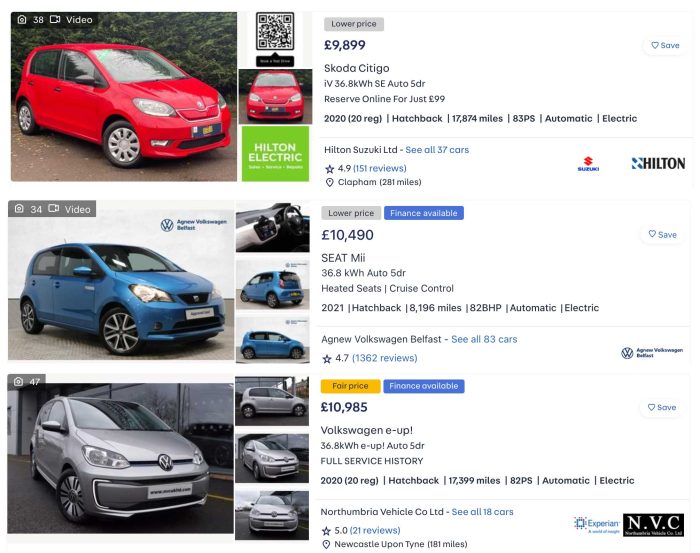


No responses yet